Get ready to dive into the mysterious world of South Carolina’s lakes and marshes. A place with creatures swimming and crawling all over the place. Some are venomous, and others have a mouth full of flesh-ripping teeth! We’re about to unveil what’s lurking in South Carolina’s 4.6 million acres of wetlands. Brace yourself for gigantic alligators, slithering snakes, snapping turtles, and more.
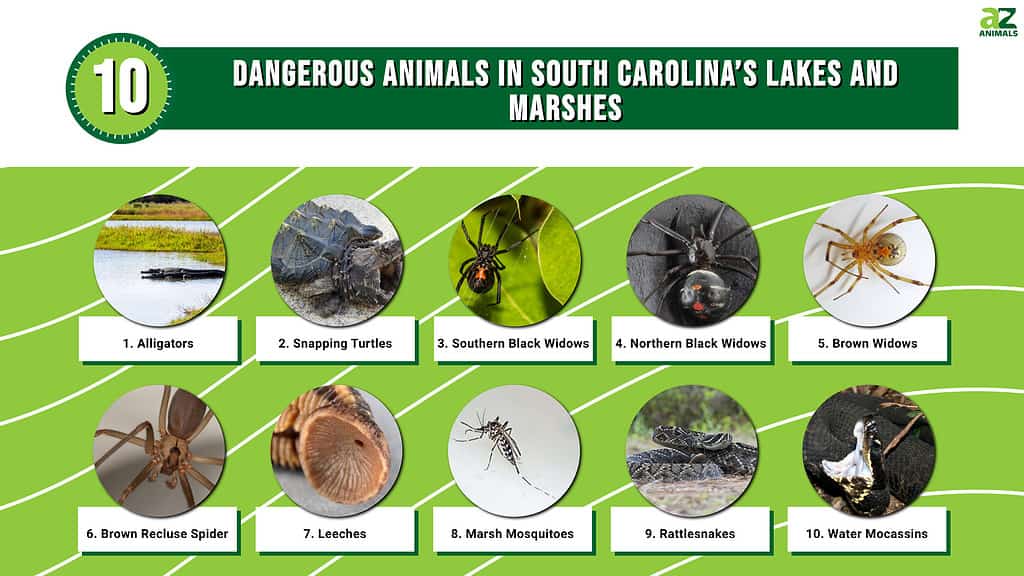
Are South Carolina’s Lakes and Marshes Dangerous?

South Carolina has a lot of lakes and rivers available for swimming.
©iStock.com/master1305
You can swim in a lot of South Carolina’s lakes and rivers. These waterways provide a relaxing and enjoyable environment for swimming with friends and family. Just make sure you prioritize safety when swimming in natural waters. Like any activity, there are risks involved.
The CDC’s Healthy Swimming website has helpful information to ensure a safe and healthy swimming experience. For instance, you should keep an eye open for South Carolina’s swimming advisories. Swimming advisories exist for certain rivers and streams in South Carolina to warn of potential health risks.
South Carolina’s Swimming Advisories
Swimming advisory signs are placed in areas where high bacteria levels have been detected and where swimming is common. These advisories come from the South Carolina Department of Health and Environmental Control (DHEC). The DHEC tests water bodies across the state to monitor bacteria levels.
Dangerous Animals in South Carolina’s Waters
Now let’s dive into the different animals, big and small, that you might encounter while out for a swim. From alligators to water mocassins, there are a lot of species you’ll want to avoid running into.
- American Alligator
- Snapping Turtles
- Southern Black Widow
- Northern Black Widow
- Brown Widow
- Brown Recluse Spider
- Leeches
- Marsh Mosquitoes
- Rattlesnakes
- Water Mocassin
Alligator

Alligators are ambush predators who wait for their prey to get close before striking.
©Kristi Blokhin/Shutterstock.com
Alligators are among the most dangerous animals swimming in South Carolina’s lakes. They’re also one of the most fascinating creatures in the world. These ancient beasts can grow over 13 feet and weigh up to 1,000 pounds. They have powerful tails and webbed feet for swimming. The American alligator has 74 to 80 cone-shaped teeth, and they cannot chew due to their massive jaw muscles.
Native to the southeastern United States, these reptiles primarily inhabit coastal marshlands and use wetlands, swamps, and marshes. The ACE Basin in South Carolina is one of the important nesting sites for alligators. You can also find these armored beats in salt and freshwater mixes, such as salt marshes. But since they lack salt glands, they can’t stand the salty waters for very long.
It doesn’t matter when visiting; you could run into an alligator at any time. In South Carolina, alligators are active year-round. However, they can go dormant during cold weather.
Have you ever seen an alligator in the wild? They’re easy to recognize. The American alligator is the most common species, ranging from Florida to Texas. They have a U-shaped snout, unlike crocodiles with a V-shaped snout. They also have rows of rough scales, called osteoderms, along their back, providing protection and aiding in temperature regulation.
To find the best gator hangouts, look for a company that offers coastal expeditions. South Carolina offers a lot of different guided eco-tours and excursions to view alligators and other wildlife in their natural habitat. Oftentimes, these creatures can be seen hanging out by the water’s edge, hoping to catch a meal.
Alligators are carnivores who hide in the water and wait for prey to approach before striking. Since they can’t chew, they swallow their kills whole after ripping off chunks of flesh.
Snapping Turtles
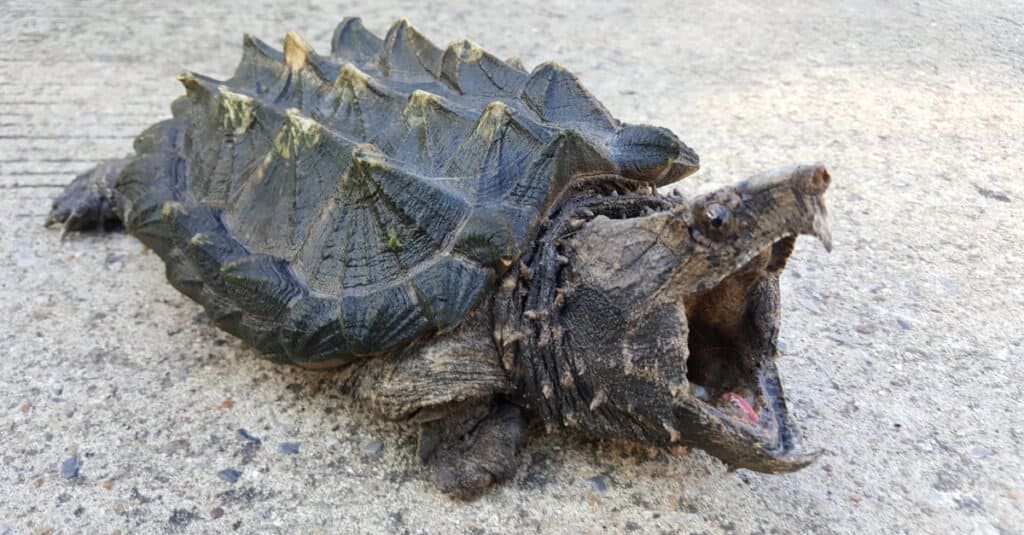
Alligator snapping turtles prefer swimming in deep streams and rivers with warm water.
©Sista Vongjintanaruks/Shutterstock.com
Watch your toes! There are snapping turtles swimming in South Carolina’s lakes and marshes. Snapping turtles range from the Gulf of Mexico to southern Alberta to Nova Scotia. In South Carolina, there are two species to look out for; the common snapping turtle (Chelydra serpentina) and the alligator snapping turtle (Macrochelys temminckii).
Common snapping turtles are active during the warmer months and settle in the shallow portion of lakes, ponds, or rivers. They prefer shallow streams with thick vegetation and muddy bottoms. As they look for the best place to chill, a snapping turtle may travel up to 165 yards in one day.
Alligator snapping turtles prefer deeper streams or rivers with warmer water, and detritus. These turtles can range in weight from 10 to 35 pounds, with shells ranging from 8 to 18½ inches in length. They have yellowish necks, legs, and tails, with a dark head.
Snapping turtles aren’t out to get you, but they have a powerful bite that can cause serious injury. Captive snapping turtles may also carry salmonella.
Widow Spiders
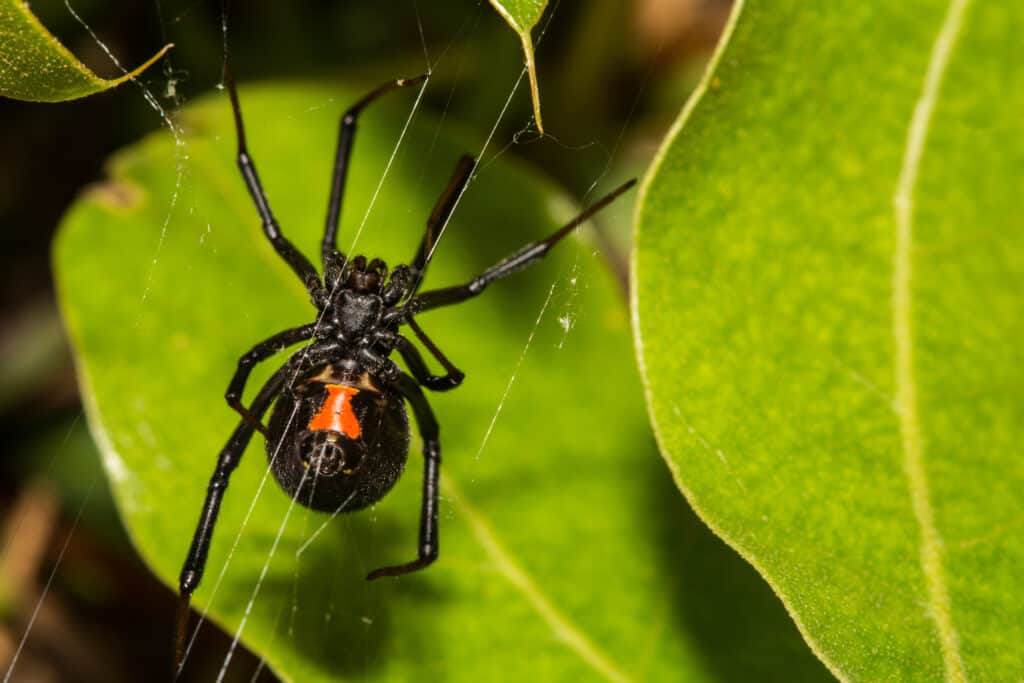
South Carolina’s lakes and marshes have three species of widow spiders, including the black widow.
©Jay Ondreicka/Shutterstock.com
Spinning their webs around the swamps and marshes, the Carolinas are home to over 600 species of spiders. Only a handful of them are dangerous, including the infamous widow’s family.
The three species of widow spiders to stay away from are the southern black widow, the northern black widow, and the brown widow. Here’s a guide to help you tell the black widows apart from the brown species.
Widow spiders in South Carolina are shy and will try to flee rather than bite humans. Bites usually occur when a spider is pressed against the skin or when reaching into dark areas where the spider is present.
Knowing how to identify and avoid these spiders will help keep you safe. Thankfully, widow spiders are among the most recognizable in the United States. Once you know what to look for, you’ll always be able to identify these unique spider species.
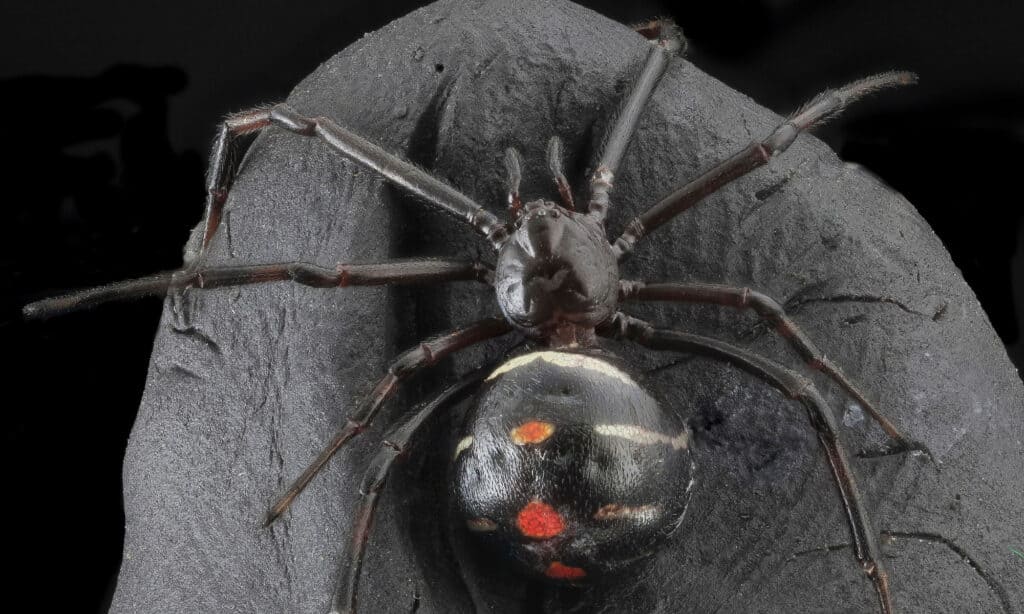
Unlike other black widows, northern black widows have a broken hourglass-shaped marking on their abdomens
©Porco_Rosso/Shutterstock.com
The southern black widow has a classic shiny shape with a red hourglass on its abdomen. The northern black widow is similar in color and size, but its red markings may appear as splotches or dots, sometimes resembling an incomplete hourglass. Finally, the brown widow is smaller and has egg sacs covered in spikes, distinguishing it from other widow species.

On the abdomen of the Brown Widow spider there is an hourglass pattern.
©Decha Thapanya/Shutterstock.com
The brown widow can be gray to brown with white and black markings on its abdomen. Females can live 1 to 2 years and lay 10 to 20 egg sacs with approximately 250 eggs in each sac. Spiderlings hatch from the egg sac after 14 to 21 days and remain in the nest area for several weeks before moving away.
Brown Recluse Spider

The brown recluse spider is often identified by the violin-shaped marking on its body.
©Nick626/Shutterstock.com
The brown recluse spider is rare in South Carolina and often confused with harmless spiders like the southern house spider. These venomous spiders have a light brown to yellow color, small bodies, very long legs, and six eyes instead of eight. Also known as violin spiders or fiddle back spiders, they have a distinct violin-shaped marking on their back, which helps in identifying them.
Brown recluse spiders are typically the size of a quarter. They prefer dark and undisturbed areas and only bite when they feel threatened or trapped. Their bites can cause necrotic (tissue-damaging) reactions in some individuals. However, a lot of bites only result in minor symptoms or no symptoms at all.
If you’re camping or hiking in South Carolina, be spider aware. Regularly inspect and shake out clothing, shoes, and sleeping bags before use, especially in areas where these spiders are known to exist. Always exercise caution and seek professional help if you suspect a venomous spider bite. Symptoms of a bite can include pain, redness, blistering, itching, and the formation of an ulcer at the bite site.
Leeches
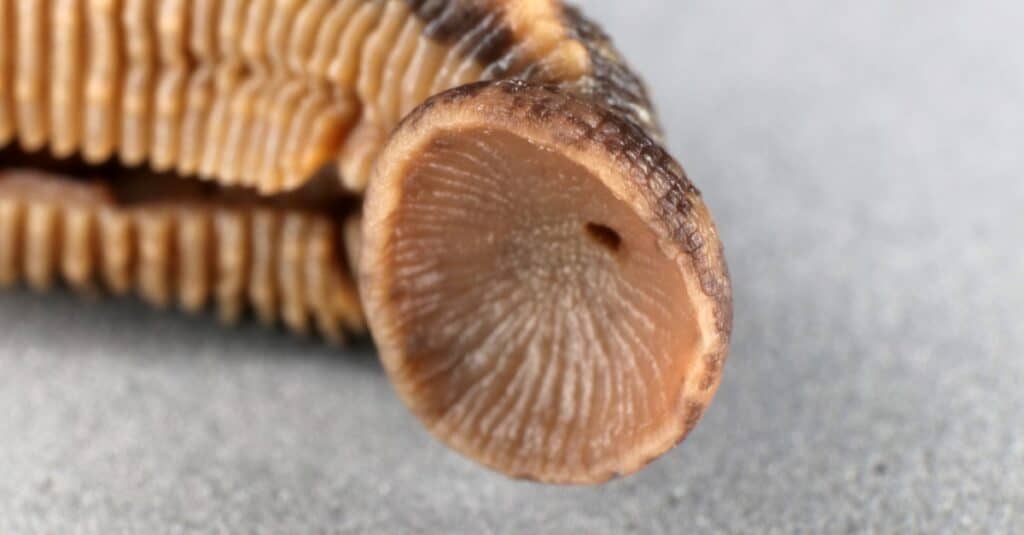
South Carolina’s lakes are home to several types of leeches.
©photowind/Shutterstock.com
There are leeches lurking in the lakes and marshes of South Carolina. A few of the species include the New England medicinal leech (Macrobdella sestertii), the terrestrial leech (Haemopis septagon), and the bi-annulate leech (Placobdella biannulata).
The New England Medicinal Leech is a species of Special Concern in Massachusetts and has a global rank of imperiled. That means it’s at high risk of extinction due to a limited range.
The terrestrial leech is found in South Carolina, particularly in Georgetown County. It prefers moist areas near water sources and feeds on earthworms.
Finally, the bi-annulate leech lives in the Blue Ridge Ecoregion in Oconee, Pickens, and Greenville Counties in South Carolina. It’s a parasite on certain salamanders.
Leeches can be creepy to think about, with their blood-sucking ways. But they’re also big players in the medical world and have been for centuries.
Hirudotherapy: Leech Medicine
Hirudotherapy is a type of treatment that involves using leeches to help with certain medical conditions. Some doctors are even recommending leeches be used for plastic surgery procedures.
How does it work? Antibiotics are given to the patient before leech therapy to prevent any complications from bacteria that live in the leech’s digestive system. Then leeches are carefully applied to specific areas of the body that need treatment.
Leeches help by drawing out excess blood and promoting better blood flow in the treated area. This can help in cases where blood circulation is not working well, such as after certain surgeries or injuries. The saliva of the leeches contains substances that can prevent blood from clotting (anticoagulants), and they have anti-inflammatory effects.
How many leeches does it take to work their magic? Usually, 1 to 10 leeches are used for each treatment session. However, the number can vary from one person to the next.
Marsh Mosquitoes
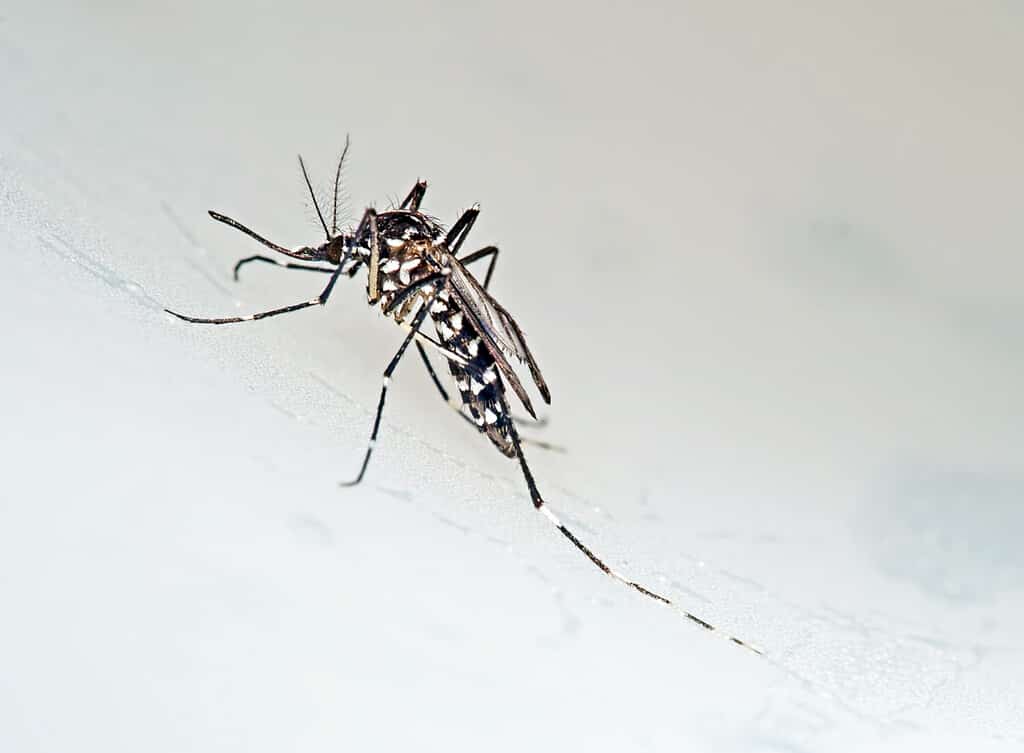
South Carolina has at least 61 species of mosquitoes.
©Sarah2/Shutterstock.com
Bring your bug spray because South Carolina is home to 61 different species of mosquitoes. These two-winged insects are closely related to gnats. Known for being annoying and delivering itchy bites, these little bugs can also spread dangerous diseases.
Infected mosquitoes spread mosquito-borne diseases through their bites. Common diseases carried by mosquitoes in South Carolina include West Nile and La Crosse encephalitis.
If you’re spending any time around a body of water in the evening or morning, you’re going to deal with mosquitoes. These insects are most active during dawn, dusk, twilight hours, and night, although some species may bite during the day in shaded areas.
Since there’s no avoiding them, insect repellent is the safest and most effective way to protect yourself from mosquito bites. You can also check out these tips from the CDC to avoid bug bites. The site has a lot of good insights on how to use EPA-registered insect repellents and more. You’ll learn how DEET, picaridin, lemon eucalyptus (OLE) oil or PMD, and IR3535 are common active ingredients for effective mosquito repellents.
Rattlesnakes
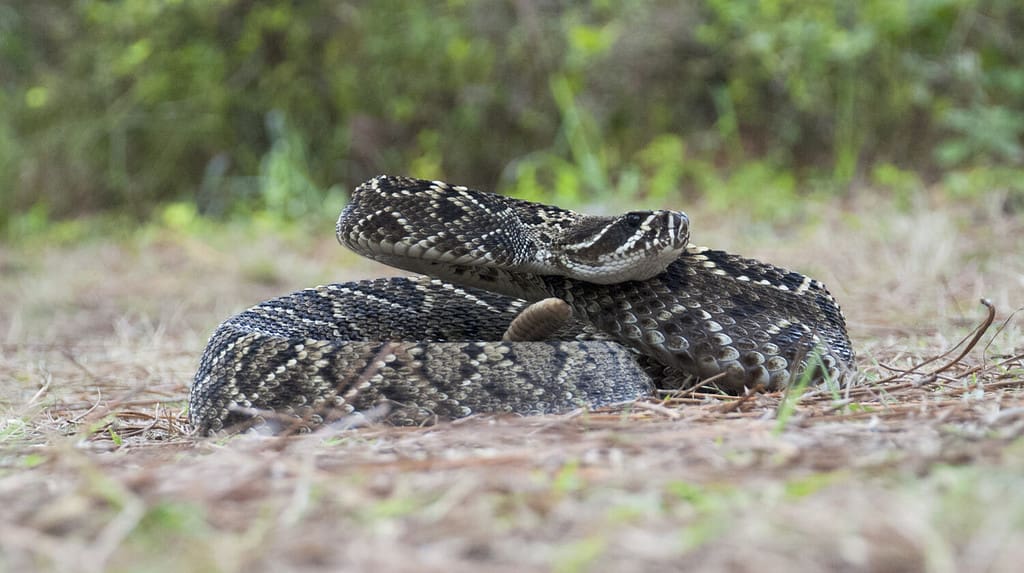
There are three types of rattlesnakes in South Carolina, and they’re all venomous.
©Brittany Mason/Shutterstock.com
South Carolina is home to 36 species of snakes, six of which are venomous, and three are rattlesnakes. The state’s three rattlesnake species include the timber, pygmy, and eastern diamondback. The ominous rattling sound produced by their tail serves as a warning when they feel threatened. Each snake can deliver a venomous bite to defend themselves if necessary.
Timber rattlesnakes belong to the reptile class Reptilia and have a grayish color with a stripe down their back that can be orange, yellow, pinkish, brown, or black. Their distinct pattern and coloration help them blend in with their surroundings on the ground.
Even though they’re terrestrial, land-loving snakes, timber rattlers sometimes take to the trees. It takes a lot of snake power for the snake to haul itself up a tree. Adult timber rattlesnakes can reach lengths of 2.5 to 5 feet, with reports of some growing up to 7 feet. They can slither up the tree 80 feet or higher with focus and determination.
If you want to see a snake up close, the state offers many good, safe opportunities. For instance, the Greenville Zoo and Riverbanks Zoo and Garden are two public locations in South Carolina where live specimens of snakes and other wildlife can be observed.
Water Mocassins
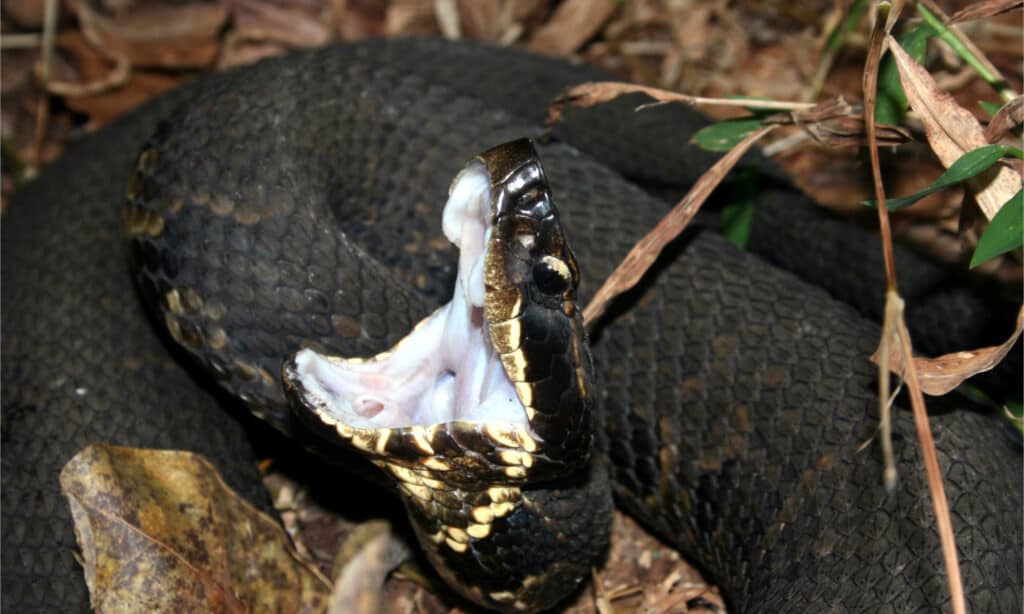
Water moccasins belong to the Crotalinae family of pit vipers.
©Psychotic Nature/Shutterstock.com
As you prepare to dive into the lake, ensure you’re being snake smart. Avoid swimming in areas where you might run into a defensive cottonmouth. Cottonmouths, or water mocassins, are venomous aquatic snakes that belong to the Crotalinae family of pit vipers. This family includes rattlesnakes and copperheads.
Like other pit vipers, water moccasins have elliptical pupils and big triangular-shaped heads. On the side of their head lays heat-sensing pits and venomous fangs. These water snakes typically inhabit the sandhills and coastal plain regions, but they do not occur in the upstate or mountain regions of South Carolina. They prefer swamps, streams, floodplains, and other wetland habitats.
How dangerous are water moccasins? Any wild animal can threaten people, but that doesn’t mean they target humans as prey. Most snakes either remain still or flee when approached by humans.
If a bite does occur, you should seek medical attention immediately. The water moccasin’s venom is used to trap and digest prey. It can also pose a serious risk to humans. The most common symptoms after a water moccasin bite or envenomation include pain, swelling, and bruising.
Water moccasin envenomation requires an interprofessional team approach involving healthcare professionals from different disciplines. In other words, it takes more than one doctor to set things straight. An envenomation recovery team includes emergency providers, nurses, toxicologists, and pharmacists. Working together, they can assess the patient and possibly administer anti-venom.
South Carolina’s Lakes and Marshes: Over 4.6 Million Acres

The 4.6 million acres of wetlands in South Carolina are home to waterfowl like the American black duck.
©Paul Reeves Photography/Shutterstock.com
South Carolina has nearly 4.6 million acres of wetlands, with 90% being freshwater. This accounts for about 23.4 percent of the state’s surface area. Only two other states, Florida and Louisiana, have a higher percentage of land area as wetlands than South Carolina.
Wetland types in South Carolina include Carolina Bays, Pocosins, bogs, seeps, bottomland hardwood forests, tidal freshwater marshes, and tidal salt marshes. These waters can be coastal/tidal or inland/non-tidal and are categorized into palustrine, lacustrine, riverine, estuarine, and marine systems. They provide habitat for plants and animals, including threatened and endangered species. And South Carolina wetlands serve as wintering areas for migrating birds, supporting many waterfowl species.
Bog vs. Seep vs. Wetland
Bogs are wetlands with peat deposits and may have carnivorous plants like pitcher plants. Seeps are wetlands with groundwater coming from the surface. Finally, wetlands like bottomland hardwood forests are important for storing water during floods.
Summary of 10 Dangerous Animals Found in South Carolina’s Lakes and Marshes
| Number | Animal |
|---|---|
| 1 | Alligators |
| 2 | Snapping Turtles |
| 3 | Southern Black Widows |
| 4 | Northern Black Widows |
| 5 | Brown Widows |
| 6 | Brown Recluse Spider |
| 7 | Leeches |
| 8 | Marsh Mosquitoes |
| 9 | Rattlesnakes |
| 10 | Water Mocassins |
The photo featured at the top of this post is © digidreamgrafix/Shutterstock.com
Thank you for reading! Have some feedback for us? Contact the AZ Animals editorial team.






